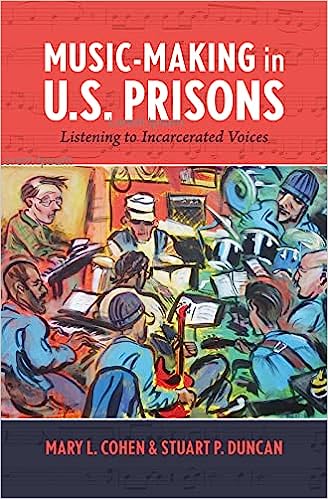 Review of Music-Making in U.S. Prisons: Listening to Incarcerated Voices
Review of Music-Making in U.S. Prisons: Listening to Incarcerated Voices
Reviewed by: Joel Spence, Queensland Conservatorium Griffith University Dr. Alexis Anja Kallio, Queensland Conservatorium Griffith University
Authors: Mary L. Cohen & Stuart P. Duncan
Book: Cohen, M. & Duncan, S.P. (2022). Music–Making in U.S. Prisons: Listening to Incarcerated Voices. Wilfrid Laurier University Press
Music Making in U.S. Prisons: Listening to Incarcerated Voices is a powerful and in-depth insight into music-making in the U.S. prison network led by Mary L. Cohen one of the most prolific international arts-health led researchers and human rights advocates through her work in collaborative communities, music-making, songwriting, and choir productions with the US Prison system. This is supported by the extensive prison education and music program experience and knowledge of co-author Stuart P. Duncan, providing readers with over a decade of scholarship and practical insights between the two authors. The book argues the importance of creating collaborative communities through the connection between those incarcerated and the wider community, using song-writing processes (specifically lyric writing) and choir (rehearsal and performance) as illustrations. For music educators, facilitators, prison staff and mental health employees working within community settings, this book provides valuable insights into participatory design and group music-making approaches which can be adapted and applied to a variety of prison, educational and community development settings.
Music has long been recognized as a potent force, with the capacity to significantly contribute to the social-emotional wellbeing of incarcerated individuals through providing opportunities for empowerment, fostering connectedness, and tackling issues of seclusion and estrangement (Kyprianides & Easterbrook, 2020). By teaching and facilitating music in prisons, incarcerated individuals may develop the skills needed to establish strong relationships not only within detention, but with their wider community, through outlets of creative expression and freedom of voice shaped by the processes of learning instrumental music, choral singing and songwriting (Cohen & Duncan, 2022). Making Music in U.S Prisons provides key insight into some of the difficulties that accompany incarceration, insights that are invaluable for developing effective programs that uphold greater quality of life making it ‘an effective part in meaningful social connection’ (Cohen & Duncan, 2022, p. 40).
It is imperative for practitioners, facilitators, and educators to comprehend the need to incorporate the perspectives and voices of those who are incarcerated in their work. The authors demonstrate that listening to incarcerated voices through songwriting can provide meaningful interactions between inmates and their peers, whilst also providing an outlet for self-expression. As the authors explain, “[w]hat was once a spark of an idea inside one incarcerated person’s heart becomes embodied in a group of singers and heard by an audience of listeners”(Cohen & Duncan, 2022, p. 127). Such activities like choral music foster social embodiment by providing an opportunity for those behind bars to find purpose, acquire new skills such as learning new languages, establish relationships, leadership, and respect whilst learning musical skills (see p. 92). Furthermore, the reader can expect to be engaged through narratives from incarcerated individuals’ participation in these activities, allowing us to understand struggles through their own stories - something that can serve as an important source of insight when creating, tailoring, and developing musical programs in prison for embetterment.
The book comprises six chapters, weaving together years of research with the narratives and lyrics of incarcerated individuals to illustrate both the detrimental impact of carceral contexts as well as instances of joy and hope (Cohen & Duncan, 2022, p. 107). The book begins with a detailed historical account in the introduction, providing a strong foundation for any new reader to the topic of U.S (or western) prison systems. This orientation to the prison industrial complex, the 'school-to-prison pipeline', and the war model of prison along with the disparities of western prison systems and laws clearly situates music in such spaces as something of a humanising anomaly. The tensions that arise between institutional structures and norms and the creative, collaborative practices of music-making described in the book raise questions that are pertinent to music educators beyond the particular context of prisons, two of which we attend to in this review: whose music? And music for whom?
Whose music?
Which, or whose, musical repertoires and activities are included in formal music education contexts are a familiar concern, extending also to questions of how to include students’ own voices, expressions, and musical worlds. The increasing emphasis of formal music education on student agency is arguably more complex in prison settings, where songwriting and music as a resource for personal expression may be one of the few arenas in which participants can “enact their subjectivity”, explore who they are and who they are becoming, “even in and against an objectifying space” (Shieh 2010, 34). Cohen and Duncan (2022) explain,
From our examination of a wide variety of songwriting programs and our research on songwriting in a men’s prison, it is clear that when incarcerated individuals have access to the means to create original lyrics and songs, they are able to process difficult emotions, reflect on their life journeys, communicate feelings for family members, and share personal stories, metaphors, and humour (p. 126).
This is not necessarily pleasant or easy work, and raises ethical questions for music program facilitators, especially when workshop participants’ experiences of incarceration are characterised by isolation, depression, fear, and anger compounding “relationship problems, missing others, regret, pain, [and] needing help” (Cohen & Wilson 2017, p. 130). The book illustrates the skill with which music educators need to identify and respond to complex emotional expressions beyond initial assumptions of music as a mere depiction of reality or process of catharsis. The authors here remind us of Rebecca Ginsburg’s (2019) concerns that “when instructors... are not aware of the challenges and risks of prison teaching” they may do more harm than good (p. 1, cited in Cohen & Duncan 2022, p. 150). While avoiding simplistic directives, Cohen and Duncan (2022) do make a case for a music education that is trauma informed and sensitive to situational and relational ethics. Indeed, reading this book alongside recent scholarship in music education that engages with Noddings’ (2002) Philosophy of Care, Trauma-Informed Care, Eudaimonia in/through music education, and the potentials of music education to navigate grief and crisis (e.g., Bradley & Hess 2021; Walzer 2021) opens many avenues for future scholarship and the development of music programs in prisons and elsewhere.
Music for whom?
Beyond enabling the articulation of individual voices, Cohen and Duncan (2022) note that music programs in prisons can forge powerful social connections through the inherently collaborative and social nature of workshops. However, this calls into play complex power relations that warrant careful attention, as Cohen and Duncan (2022) explain, “the very constructs by which music-making courses are designed constitute a method of control” (p. 151). For example, a recent qualitative metasynthesis of research focusing on music in youth justice settings argues that music programs can function to enforce normative behaviours and identities, demanding conformity with majoritarian ideals of citizenship (Kallio 2022). This raises questions as to the potentials for resistance from within and whether music program facilitators can serve as “agents of change in an environment that is profoundly complex, individualised and difficult for those living through the experience of incarceration” (Cohen & Duncan, 2022, p. 164). As articulated by music education scholar and prison music educator Eric Shieh, articulating the importance of recognising,
That I am implicated in a system of mass incarceration in the U.S., and that my work must be engaged in solidarity with the incarcerated, their families, and advocates for the reform of our justice system (cited in Cohen & Duncan 2022, p. 150).
The ethical deliberations required of music program facilitators in considering who these musical experiences are for are made even more complex when considering the often-vast divide between the cultural practices and lifestyles of music program facilitators in relation to participants. While Cohen and Duncan (2022) note that “for arts educators to be agents of change, they must realise how complex, individualised, and difficult life can be for people in prison” (p. 164) and emphasise the need for facilitators to reflect upon their work continually critically, we (the authors) can’t help but wonder whether reflexivity and empathy is enough. Cohen and Duncan (2022) describe a response by an audience member of a performance of the East Hill Singers,
For perhaps the first time, the audience was confronted by a group of male prisoners who challenged our stereotypes about them. Here were men singing powerfully about spiritual realities who, regardless of their failures, were undeniably humanalong with the rest of us” (Waters 1997, 18 as cited in Cohen & Duncan, p.105-106).
The individualisation of “failures” as an empathetic response here highlights the tensions between music for incarcerated individuals and the potentials of music to challenge the prison industrial complex, tensions that Cohen and Duncan’s book faces head on.
As music educators increasingly expand beyond the familiar school classrooms or community music settings to engage with new institutional structures, communities, and practices, they are required to “enter onto territory in which [they] are unfamiliar and, to some significant extent, therefore unqualified” (Suchman, 1994, p. 25). While the particular focus of this book on U.S. prisons may seem extreme, these insights are relevant for many music educators and facilitators working in unconventional settings and challenge music teacher education to imagine new ethical, practical, and theoretical challenges. Music–Making in U.S. Prisons: Listening to Incarcerated Voices serves as a call to deeply relational, engaged music-making and research and reminds us of the complexity involved as so many of us strive to make difference in and through music education.
References
Bradley, D., & Hess, J. (2021). Trauma and resilience in music education: haunted melodies. Taylor & Francis Group. Retrieved May 3, 2023, from http://public.eblib.com/choice/PublicFullRecord.aspx?p=6738475.
Cohen, M. L., & Wilson, C. M. (2017). Inside the fences: Pedagogical practices and purposes of songwriting in an adult male U.S. state prison. International Journal of Music Education, 35(4), 541-553. https://doi.org/10.1177/0255761416689841
Kallio, A.A. (2022). The transformative potentials and politics of music in juvenile justice settings. Music Education Research, 24(4), 405-416. https://doi.org/10.1080/14613808.2022.2046719
Kyprianides, A., & Easterbrook, M. J. (2020). “Finding rhythms made me find my rhythm in prison”: The role of a music program in promoting social engagement and psychological well-being among inmates. The Prison Journal, 100(4), 531-554.
Shieh, E. (2010). On punishment and music education: Towards a practice for prisons and schools. International Journal of Community Music, 3(1), 19-32.
Suchman, L. (1994). Working relations of technology production and use. Computer Supported Cooperative Work, 2, 21–39. https://doi.org/10.1007/BF00749282
Walzer, D. (2021, April). Fostering trauma-informed and eudaimonic pedagogy in music education. In Frontiers in Education (Vol. 6, p. 647008). Frontiers Media SA.
About the Reviewers
Joel Spence is a secondary school music educator (Queensland and Victoria, Australia) and accredited Social Worker (Australian Association of Social Workers). His current PhD research at the Queensland Conservatorium Griffith University investigates community music and social inequalities with a case study focusing on community activism, songwriting and performance in Roebourne/Ieramugadu, Western Australia.
Dr. Alexis Anja Kallio is Deputy Director (Research) of the Queensland Conservatorium, Griffith University. A specialist in the politics of music education, Dr. Kallio works in close collaboration with community groups, policymakers, and educational institutions to explore how music education policy, practice, and research can structure opportunities for equity and justice. She is editor of Difference and Division in Music Education (2021, Routledge), co-editor of The Politics of Diversity in Music Education (2021, Springer) and co-editor of Music, Education, and Religion: Intersections and Entanglements (2019, Indiana University Press).
Where to buy
Paperback and Digital Form is available through Amazon.com here.











